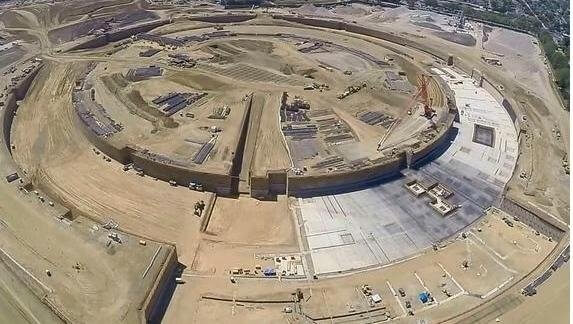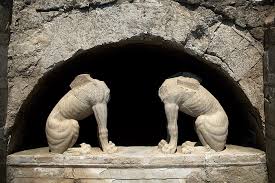
Amphipolis

Brief Overview
In 2012 Greek archaeologists unearthed northeast of Amphipolis at a location called the Kasta Hill, a vast tomb, the biggest burial tomb ever unearthed in Greece.
The perimeter is 497 meters long, and is made of limestone covered with marble.
Three sections have been revealed by the excavation, each closed with a stone wall. There are two sphinxes just outside the entrance to the tomb. Two of the columns supporting the roof in the first section are in the form of Caryatids, apparently mimicking the fourth ce. BC style.
The large size of the tomb indicates the prominence of the burial made there. The identity of the burial remains unknown, since the excavation is still going on. Dr. Katerina Peristeri, the archaeologist heading the excavation of the tomb, dates the tomb to the late period of the 4th Century BC, which is the period after the death of Alexander the Great (323 BC).
In the course of the excavation, directly behind the Caryatids and in front of the Macedonian marble door leading to the "third" chamber, a pebble mosaic showing the abduction of Persephone by Hades was discovered.
Hades' chariot is drawn by two white horses and led to the underworld by Hermes. The mosaic verifies the Macedonian character of the tomb and its date in the last quarter of the 4th Century B.C.
As the head of one of the sphinxes was found inside the tomb behind the broken door, it is clear that there have been intruders in the tomb, probably in antiquity.
In Detail
Amphipolis
Amphipolis is a municipality in the Serres regional unit of Greece. The seat of the municipality is Rodolivos and historical seat of the First. Amphipolis was a rich city (polis) in ancient Macedonia.
It was famous for events such as the battle of the Spartans and Athenians in 424BC, and as the place where Alexander the Great prepared for campaigns leading to his invasion of Asia. Alexander's three finest admirals, Nearchos, Androsthenes and Laomedon, resided here and after Alexander's death, his wife Roxane and their small son Alexander IV were exiled and later murdered here.
The unique and beautiful "Lion of Amphipolis" monument nearby is a well-known destination for visitors. Partial excavations in the city have so far revealed important ancient walls, buildings and tombs. At the nearby vast Kasta burial mound, an important ancient Macedonian tomb has recently been revealed.
[1]

The Tomb
Discovery
In 2012 Greek archaeologists unearthed a large tomb within the Kasta Hill, the biggest burial mound in Greece, northeast of Amphipolis. The large size of the tumulus indicates the prominence of the burials made there. The perimeter wall of the tumulus is 497 meters long, and is made of limestone covered with marble.
The tomb comprises three chambers separated by walls. There are two sphinxes just outside the entrance to the tomb. Two of the columns supporting the roof in the first section are in the form of Caryatids, in the 4th century BC style. The excavation revealed a pebble mosaic showing the abduction of Persephone by Hades directly behind the Caryatids and in front of the Macedonian marble door leading to the "third" chamber. Hades' chariot is drawn by two white horses and led to the underworld by Hermes. The mosaic verifies the Macedonian character of the tomb. As the head of one of the sphinxes was found inside the tomb behind the broken door, it is clear that there were intruders, probably in antiquity.
The identity of the burial remains unknown and the excavation is continuing. Dr. Katerina Peristeri, the archaeologist heading the excavation of the tomb, dates the tomb to the 4th Century BC, the period after the death of Alexander the Great (323 BC).
[2]
Official Website and Map
Further Sources
"The Amphipolis Tomb"
"Media (Greek)"
"Media"
Our Mobile Application
Check out Our Mobile Application "Ancient Greece Reloaded"


